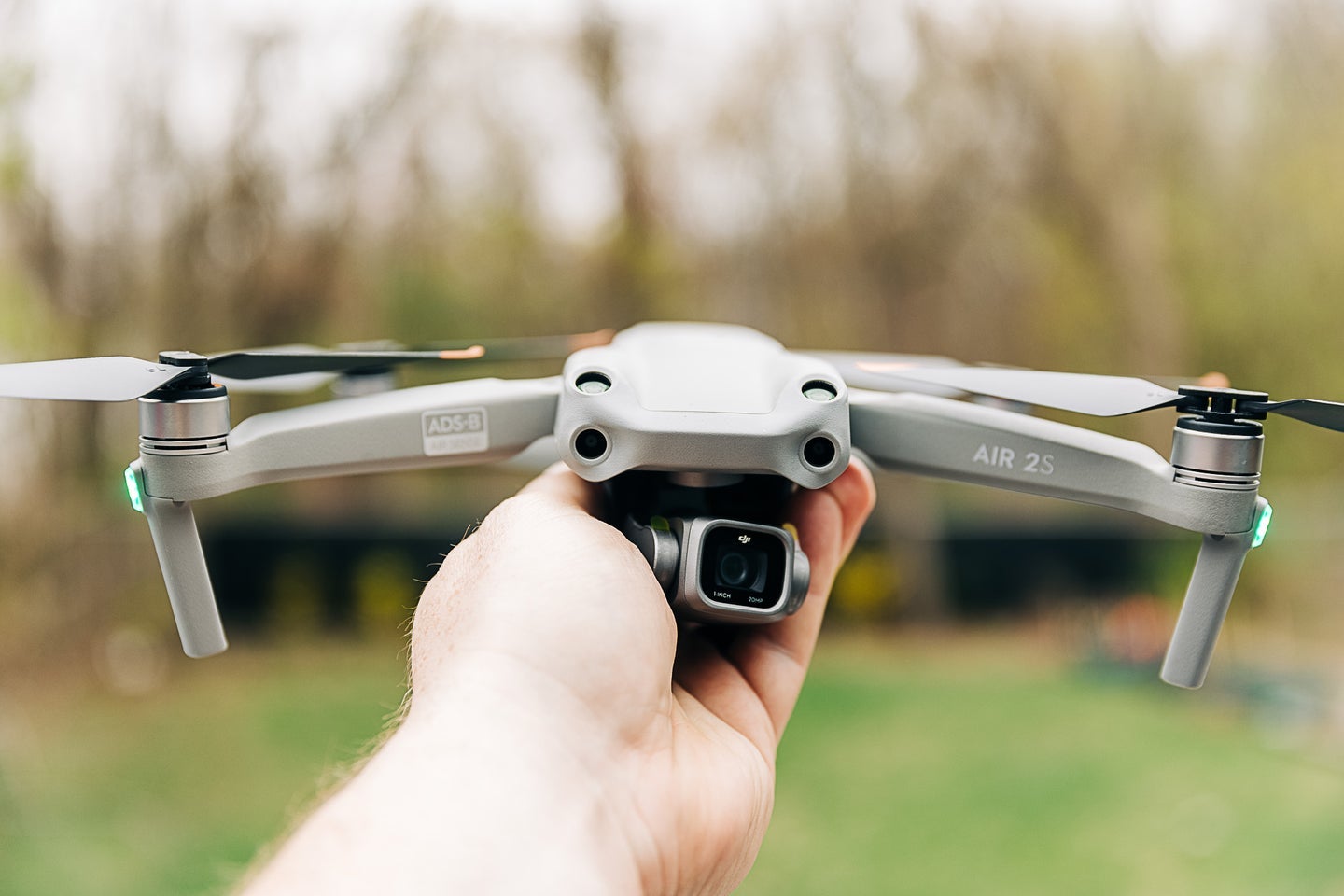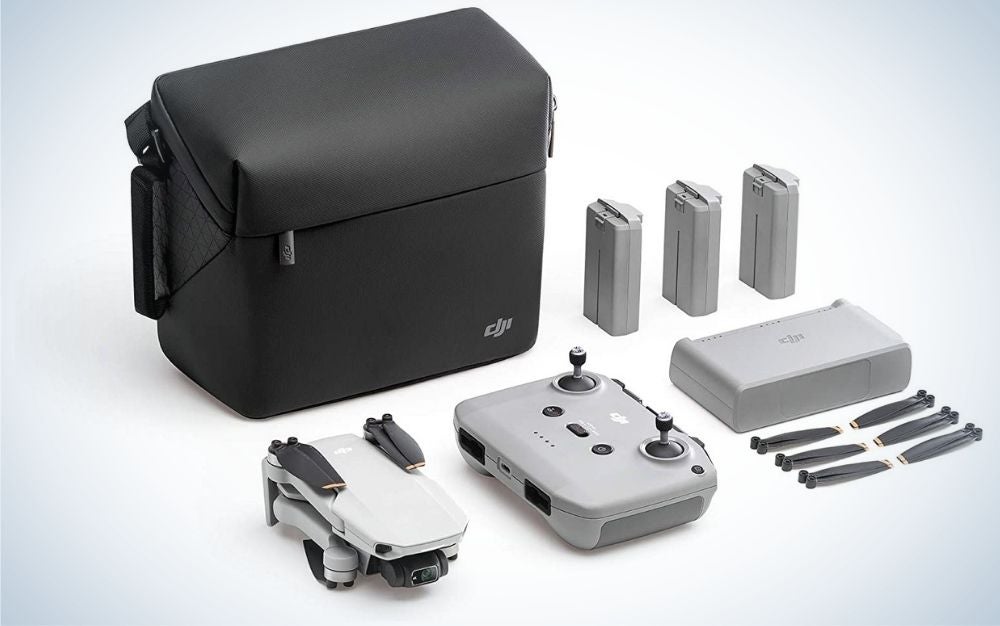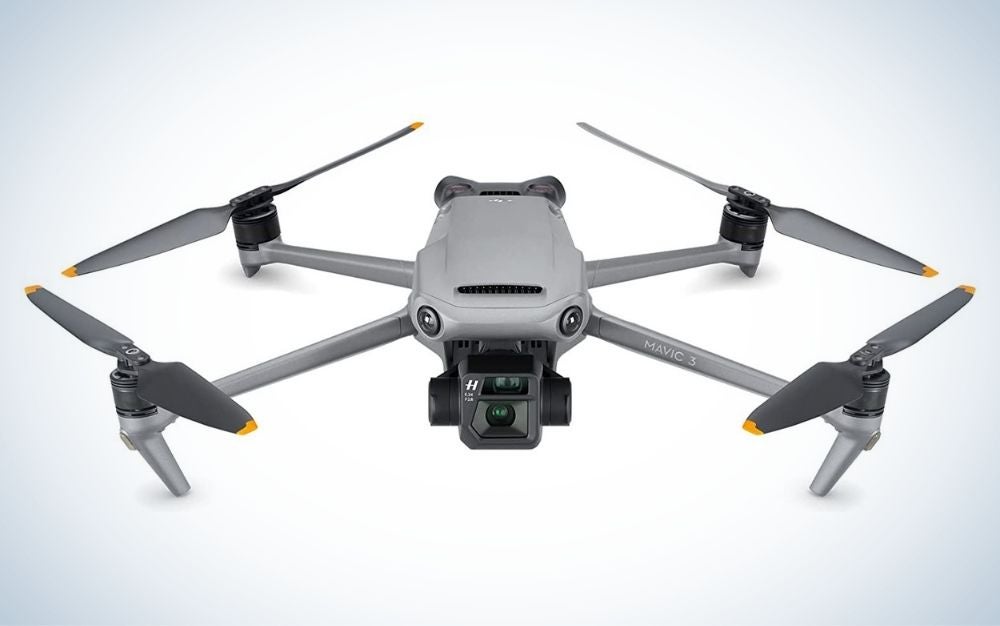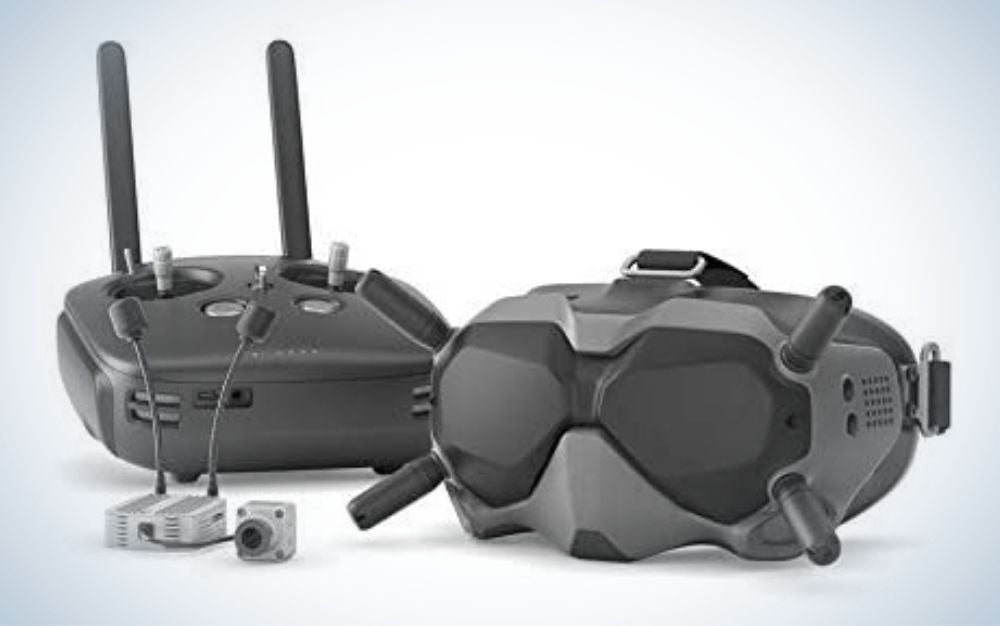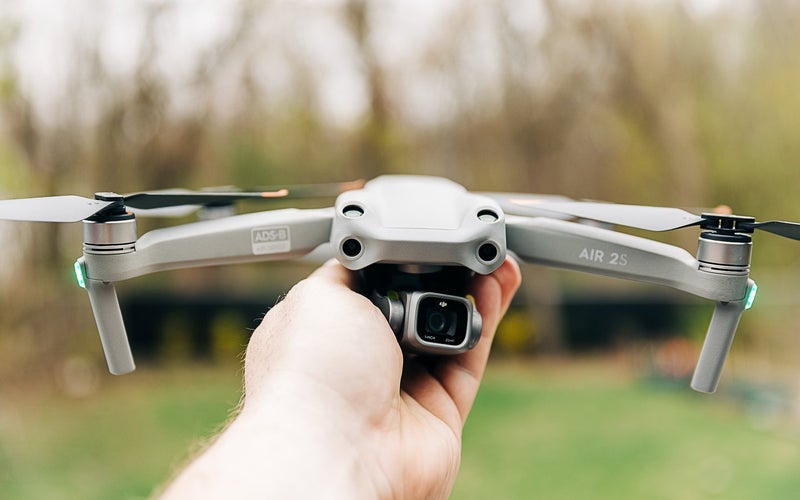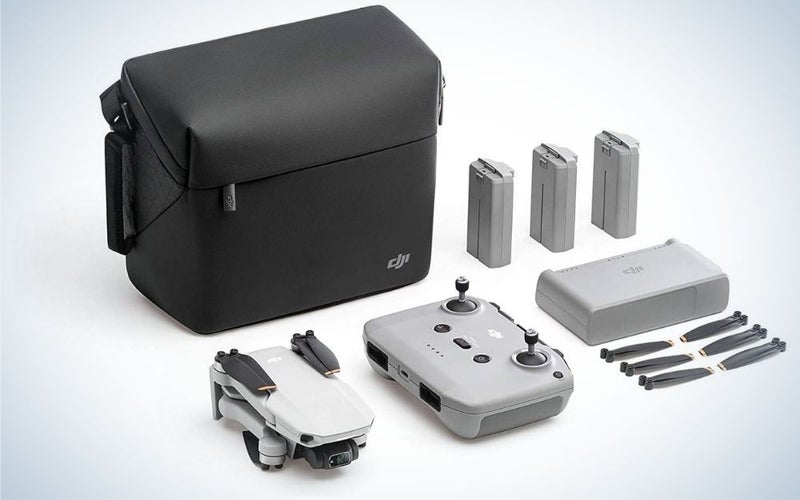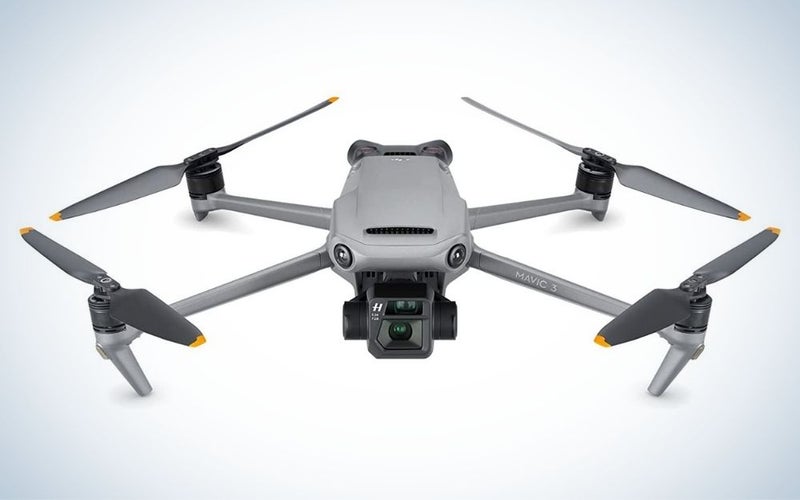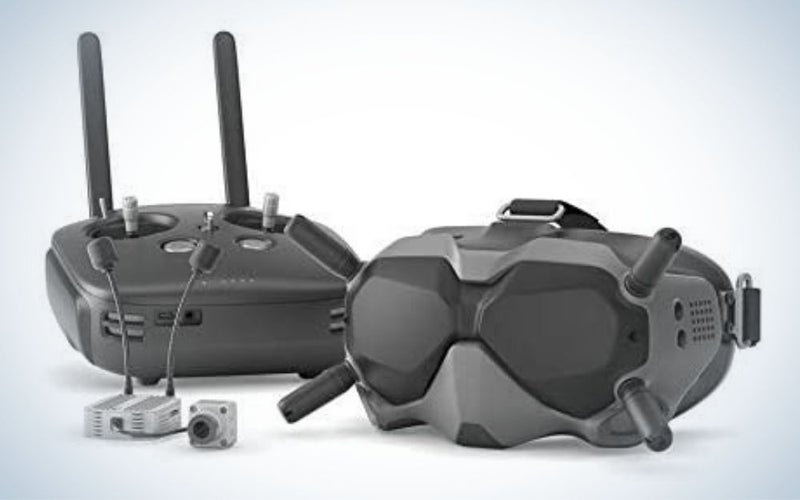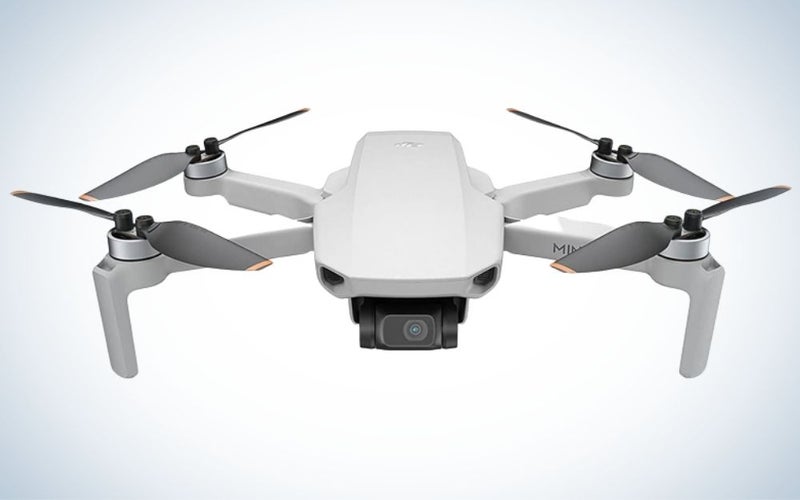We may earn revenue from the products available on this page and participate in affiliate programs. Learn more ›
DJI is one of the most well-known and sought-after brands for drones. Amateurs of aerial photography and big-budget commercial projects alike utilize the company’s diverse range of offerings. A drone is a great way to capture beautiful overhead perspectives that would be impossible without access to a hot air balloon or helicopter. They allow you to expand the possibilities of your creative projects. Read on to learn more about the best DJI drones.
- Best overall: DJI Air 2S
- Best for beginners: DJI Mini 2
- Best foldable: DJI Mavic 3
- Best FPV: DJI FPV drone
- Best budget: DJI MIni SE
How we picked the best DJI drones
In selecting products for this guide, we focused on price, camera quality, ease of use, and flight time when making our suggestions. In most cases, cost, quality, and usability are connected in DJI drones. An inexpensive model is often for beginner drone pilots who are not producing professional-level content, while pricier models feature better camera specs and are better for more experienced users.
The best DJI drones: Reviews & Recommendations
Best overall: DJI Air 2S
Stan Horaczek
Why it made the cut: The DJI Air 2S has exceptional video quality packed inside a compact, foldable body.
Key features
- Video resolution: 5.4K/30fps
- Image resolution: 20 megapixels
- Flight time: 31 minutes
- Weight: 595 g
Pros:
- Four-way obstacle avoidance detection
- 31 minute flight time
- 3-axis gimbal with a 22mm F/2.8 fixed-aperture lens
Cons:
- Struggles in windy situations
We named the DJI Air 2S the best DJI drone overall because it pairs high-end video specs with a compact, foldable body size—a perfect combo for a high-end consumer drone. Automated flight modes such as cinematic shots and hyperlapse make it easy to create beautiful, shareable video content without pro-level flying skills. In addition, its obstacle avoidance detection system gives the pilot peace of mind while the drone is in action. It can capture video up to 5.4K/30fps, and pro-level video shooters will appreciate 10-bit D-Log and HLG capture for increased color grading functionality. The 20 megapixel 1″-type CMOS sensor and 22mm F/2.8 fixed-aperture lens offer an 88-degree field of view. On the photo side, it can shoot RAW or JPEG and stitch together a variety of panoramic shots.
Best for beginners: DJI Mini 2
DJI
Why it made the cut: The DJI Mini 2 is an easy-to-fly, sub-250 gram drone with 4K video capabilities.
Key features
- Video resolution: 4K/30fps
- Image resolution: 12 megapixels
- Flight time: 31 minutes
- Weight: 249 g
Pros:
- Sub-250 gram weight means no need to register with the FAA
- 4K video capabilities with zoom
- 31 minute flight time
- Five quick shot modes
Cons:
- Lacks obstacle avoidance sensors
- Lacks intelligent flying modes
A best drone for a beginner, the DJI Mini 2 is a foldable, palm-sized drone that can still shoot 4K video and capture Raw photos. Since the drone is under 250 grams, you don’t need to register it with the FAA before getting started if you are a recreational pilot. The Mini 2 features a 12 megapixel 1/2.3″ CMOS sensor, a 24mm F/2.8 fixed aperture lens, and a camera mounted on a 3-axis gimbal for smooth shots. Although it lacks intelligent flying modes, QuickShot modes like rocket and circle allow users to capture pre-programmed motions with the drone with minimal effort. Unfortunately, DJI has omitted obstacle avoidance sensors to keep the weight and price of this drone on the low end, so although it has a decent battery life, you will want to keep a close eye on it while it’s in the air.
Best foldable: DJI Mavic 3
DJI
Why it made the cut: The DJI Mavic 3 has a foldable body, making it great for travel, with dual lenses that will appeal to pro-level users.
Key features
- Video resolution: 5.1K/50fps
- Image resolution: 20 megapixels
- Flight time: 46 minutes
- Weight: 895 g
Pros:
- Incorporates Hasselblad’s exceptional color rendering
- Dual controller support
- 10 obstacle avoidance sensors
Cons:
- Disappointing sensor on the zoom camera
- High price point
The DJI Mavic 3 pairs excellent camera specs with a portable, foldable body, making it the best foldable drone and ideal for a high-level user looking for something easy to travel with. This new version of the Mavic has an extended flight time of 46 minutes, longer than many other options. In addition, the newly improved Omnidirectional Obstacle Sensing makes this thing nearly crash-proof.
Photographers and videographers alike will appreciate the high-end specs in the Mavic 3. It has dual cameras, providing a nice range of focal lengths for different shooting situations, though they have very different specs. One is a 4/3 CMOS, 20 MP Hasselblad with a 24mm equivalent lens. It has an aperture range of f/2.8-f/11, can shoot JPG and RAW, and integrates Hasselblad’s Natural Color Solution tech, making for beautiful color accuracy when shooting. In addition, it can shoot up to 5.1K/50fps video. The tele camera has a 1/2-inch CMOS sensor and is capable of 12MP photos. The lens is 162mm, and it has an additional 4x zoom. Unfortunately, the tele camera can only take JPG files, and the video resolution is a lower 4K/30fps.
Best FPV: DJI FPV Drone
DJI
Why it made the cut: The DJI FVP drone features intuitive flight modes that make this an acceptable tool for new users and seasoned FVP fliers.
Key features
- Video resolution: 4K/60fps
- Image resolution: 12 megapixels
- Flight time: 20 mins
- Weight: 795 g
Pros:
- Three flying modes for different experience levels
- Excellent stabilization
- Emergency brake and hover feature
Cons:
- Expensive
- If you crash, you will need to send it in for repairs
DJI makes the intuitive FVP style of flying slightly more accessible to beginners with the DJI FVP drone. FVP flying is unique in that the drone control is from the pilot’s perspective, meaning you see what the camera on the drone sees for a more immersive flight experience. Previously only available to fliers who had knowledge of radio frequencies and the ability to build their own rig, this drone opened the style of flying up to a wider demographic. In fact, DJI helps users ease into the FVP experience with three different flying modes geared for different comfort levels.
The DJI FVP drone features intelligent flight modes, DJI’s RockSteady EIDS gimbal, and comes with a pair of DJI Goggles V2. In addition, it has obstacle avoidance sensors on the front and bottom of the drone and an emergency brake feature on the drone’s controller—a much-appreciated feature because if you crash, you will likely be sending this drone back to DJI for repairs.
The image and video quality of this DJI FVP drone allow you to capture video at 4K/60fps and stills as 3840×2160 JPEGs. It’s not as high as other options, but you can still capture great-looking footage.
Best budget: DJI MIni SE
DJI
Why it made the cut: The DJI Mini SE is an inexpensive model from a trusted brand, making it a great tool for the drone-curious who aren’t looking to break the bank with a purchase.
Key features
- Video resolution: 2.7K/30fps
- Image resolution: 12 megapixels
- Flight time: 30 minutes
- Weight: 249 g
Pros:
- Sub-250 gram weight means no need to register with the FAA
- 30 minute flight time
- Great for beginners
- Affordable price
Cons:
- No 4K video capture or RAW photos
- Lacks obstacle avoidance sensors
This foldable, palm-sized drone is one of the best DJI drones for beginners because of its small size and its low price point. Since it weighs under 250-grams, you can use it without registration with the FAA as long as it is for recreational purposes only. It lacks obstacle avoidance sensors but does have two vision positioning sensors so that it can hover in place. The 12 megapixel 1/2.3″ CMOS sensor supports 2.7K/30fps video capabilities and JPEG photos. The drone has a flight time of 30 minutes and can travel up to 2.5 miles. Although it lacks some of the high-end controls and creative features found in other drones in this guide, you simply can’t beat the price.
Things to consider before buying the best DJI drones
Rules and regulations
New and seasoned drone operators alike should be aware of the rules and regulations in their region for flying drones. For example, in the United States, all drones over 250 grams must have registration with the Federal Aviation Administration (FAA). Because of this, if you are buying your first drone, we’d recommend looking for something under 250 grams.
Regardless of size, all drone pilots need to be aware of no-fly zones before taking off. There are also different limits for how high you can fly your drone based on air space rules, so familiarize yourself with those. And, if you are doing anything other than just flying for fun for yourself, different restrictions apply. Any commercial activity, which the FAA defines broadly, requires you to pass a test to be an FAA-Certified Drone Pilot.
Features
Even just DJI drones come with quite a range of features. Therefore, deciding on how you plan on using the drone and which features are most important to you is essential. For example, if you want to focus on just photography, you may want to pick something different than someone who is a videographer.
Battery life and flight time
For almost all drone pilots, battery life and flight time will be one of the most important things to look at. This is especially true if you plan to travel with your drone or have limited access to power for charging batteries.
Tracking and flight modes
Different levels of drones will offer different types of flight modes and tracking. For example, a higher-end drone with tracking will be necessary if you want to take footage with the camera following the action.
Camera specs
If you plan to use your drone for video or photography, the camera’s specs in the drone will be important. Looking at the resolution, exposure settings, frame rate, zoom options, video quality, and more will help you ensure the drone meets your documenting needs.
Device Range
Another important consideration is how far your drone can fly while still being within range of the transmitter. A lower range will probably be acceptable if you only fly for fun. But, if you are flying in situations where you need the drone to cover greater distances, getting a drone with a far range will be helpful.
Where you will use your drone
If you plan to travel extensively with your drone, a foldable model might be the best option to consider—especially if you plan to bring your drone along for hikes or bike rides. You can easily pack foldable drones in a backpack and still fit other items, which is important for adventures. Obstacle avoidance features may also be more important in some locations, such as cities versus wide-open fields.
Budget
When shopping for a DJI drone, your budget will play a significant role in determining what drone is suitable for you. As with most gear, the price of your drone is dependent on things like features and size. For example, a drone that shoots 4K footage, has a high-quality lens, and long-range operating distances will cost more than a drone under 250 grams without those features.
Experience level
Although drones have become more widely available for novice users, and there are even kid-friendly drones, they do come with a learning curve. Depending on your experience level and how you intend to use your drone, you should also consider the potential for accidents and losing the device.
Finding a balance between your budget and risk will help you fly more comfortably. Spending money on the highest-end drone only to crash it right away because you are new to flying is far from ideal. However, DJI offers protection plans, which could be a good option, especially for the more expensive versions.
FAQs
Q: How far can the Mavic mini fly?
DJI’s Mavic Mini can fly up to six miles and remain in the air for up to 31 minutes on one fully charged battery.
Q: What is the most advanced DJI drone?
The DJI Mavic 3 is currently billed as the flagship drone. The Mavic 3 has a dual-camera system with a 4/3 CMOS Hasselblad camera, plus a half-inch sensor tele camera. In addition, it has a fly time of up to 46 minutes, a 9.3-mile transmission range, and features such as omnidirectional obstacle sensing.
Q: Which DJI drone flies the longest?
The DJI Mavic 3 has a flight time of up to 46 minutes and a range of 9.3 miles, giving it the top spot for the drone that can stay in the air for the longest time on a single charged battery.
Final thoughts on the best DJI drones
- Best overall: DJI Air 2S
- Best for beginners: DJI Mini 2
- Best foldable: DJI Mavic 3
- Best FPV: DJI FPV drone
- Best budget: DJI MIni SE
The best DJI drone for you will depend on your skill level, budget, and how and where you intend to fly it. A lower-cost DJI drone will likely include less advanced features and be better for amateur fliers. In contrast, more expensive drones will feature higher-end features like 4K and higher video, advanced stabilization, and longer flight times. Keep these things in mind when shopping for your DJI drone.
Why trust us
PopPhoto has a long history of delivering the opinions of some of the sharpest and most prolific camera dorks the world has to offer. Since 1937, we’ve been reviewing cameras, providing wisdom from well-known photographers, and generally just nerding out about all that goes into making great pictures. Our current crop of writers and editors have decades of professional photography and camera writing experience among them. Collectively, we’ve probably shot with just about every camera and lens combo you can imagine—as well as some obscure stuff you may not even know about. Remember the Casio Tryx folding camera? PopPhoto does.
We also get that buying a camera is a big decision, which is why we’re dedicated to helping folks choose the right one (or, in our case “ones”) for their needs. Case in point: Handing over top dollar for an expensive rig may leave you unsatisfied if it doesn’t fit your preferred shooting style. Sure, a $6,000 sports-oriented DSLR can capture landscapes, but do you really need to do it at 30 frames-per-second? No, you don’t.
